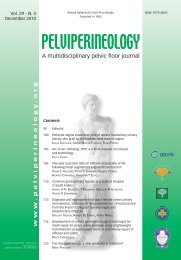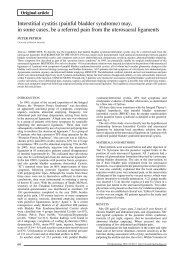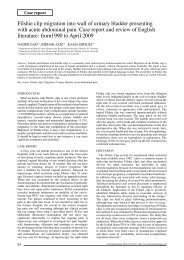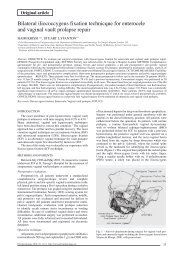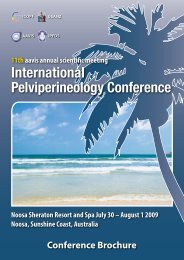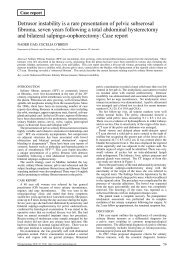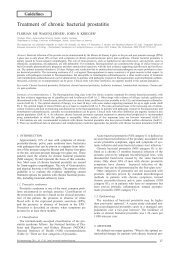This Issue Complete PDF - Pelviperineology
This Issue Complete PDF - Pelviperineology
This Issue Complete PDF - Pelviperineology
You also want an ePaper? Increase the reach of your titles
YUMPU automatically turns print PDFs into web optimized ePapers that Google loves.
P. von Theobald - E. Labbé<br />
PIVS in 102 patients), there was one failure in the patient<br />
whose prosthesis was removed on day 15. There were 2<br />
recurrences at 6 months, i.e. hysterocoele and cystocoele,<br />
one of which occurred in the patient who had an infection<br />
on the prosthesis at 5 months with, once again, complete<br />
removal of the mesh. With regard to repair of the anterior<br />
compartment (73 patients), there were 6 failures and 2 recurrences<br />
at 6 months.<br />
From a functional point of view (in 102 patients) and<br />
with regard to PIVS and the posterior prosthesis, the results<br />
included 3 cases of moderate de novo constipation, 1 case<br />
of dyspareunia that resolved after section of one of the 2<br />
PIVS side strips and also one case of urinary incontinence<br />
that previously was masked. However, in the 10 patients<br />
who presented with pre-operative dyschesia, 5 no longer<br />
have any symptoms and one has experienced considerable<br />
improvement. Concerning the anterior compartment, there<br />
were 8 cases of transient voiding obstruction, 6 cases of urinary<br />
incontinence that were unmasked, and 1 failure of the<br />
urinary incontinence treatment.<br />
DISCUSSION<br />
There were few intra-operative complications encountered<br />
with this technique (9 cases, 8.5%). None of these<br />
can be specifically attributed to the installation of the PIVS,<br />
since they all occurred during dissection of the level 2 or<br />
level 3 defect and not during the dissection for level 1<br />
(PIVS) attachment. When examined in detail, of the 4 bladder<br />
injuries that occurred during dissection of the cystocoele<br />
(including one in a patient with a past history of hysterectomy),<br />
suturing was uncomplicated in every case and in<br />
only one case the proximity of the bladder trigone required<br />
double J catheters to be inserted as a precaution. The subsequent<br />
history for these 4 patients was uncomplicated. The<br />
only case of rectal injury occurred during rectal dissection<br />
immediately above the anus; a simple suture closure was<br />
inserted together with myorrhaphy of the levator ani muscles<br />
and perineorrhaphy. It was possible to implant the<br />
PIVS normally, as it lay some distance away from the rectal<br />
suture. The subsequent history was uncomplicated, with a<br />
follow-up of 12 months. Immediate post-operative complications<br />
consisted essentially of anaemia that was encountered<br />
three times more often when hysterectomy took place.<br />
Other authors, such as Hefni, 22 argue as we do, that the<br />
uterus should be preserved in order to reduce morbidity. The<br />
3 cases of vaginal erosion (2.7%) opposite the prosthesis<br />
material (twice with a vesico-vaginal prosthesis, once with<br />
a recto-vaginal prosthesis) are consistent with the results<br />
found in the literature, and which vary considerably between<br />
0 and 40% (Tab. 1). However there are few series and the<br />
number of cases is low or concern repair of a cystocoele<br />
alone. Many different types of mesh have been used by the<br />
vaginal, abdominal or combined approach without any clear<br />
relationship appearing between the type of prosthesis, the<br />
route of approach and the rate of erosion. It should be noted<br />
that regardless of the approach for inserting the prostheses,<br />
those for which there is no erosion and those which have<br />
a very high rate of erosion are the shortest series, and thus<br />
those with the least experience. <strong>This</strong> latter factor, namely<br />
technique or experience therefore appears to be the determining<br />
factor. Our good results encourage us to continue<br />
with the same materials and the same longitudinal incisions.<br />
The same prosthetic material made of multifilament<br />
polypropylene (Surgipro ® Mesh, Tyco Healthcare, USA)<br />
has been used in our department since 1993 for laparoscopic<br />
promontofixation (5) and laparoscopic colposuspension<br />
using tapes 36 in over 400 patients with an erosion rate<br />
of less than 2%. In addition, it should be highlighted that<br />
if it is necessary to remove a multifilament prosthesis, this<br />
is achieved far more easily than for a monofilament prosthesis<br />
that tends to “unravel” and presents an important risk<br />
of leaving filaments behind that will prolong the infection.<br />
However, as was perfectly expressed by Michel Cosson: 37<br />
“the ideal prosthesis does not exist yet”.<br />
No erosion occurred on the PIVS mesh. The 2 cases of<br />
infection of the prosthesis were in patients who had undergone<br />
several operations. In one case, the infection was<br />
secondary to a vaginal erosion that occurred on the rectovaginal<br />
prosthesis at 5 months and required removal of the<br />
PIVS tape together with the posterior mesh prosthesis, but<br />
the cystocoele repair was not involved. Myorrhaphy of the<br />
levator ani muscles was carried out and the subsequent history<br />
was uncomplicated. The vault prolapse nevertheless<br />
recurred. In this case, the patient was obese and had a past<br />
history of a Richter spinofixation and myorrhaphy. In the<br />
other case the infection occurred on day 15 following a postoperative<br />
haematoma in a patient treated by PIVS alone, and<br />
this patient had a past history of promontofixation then hysterectomy<br />
and Richter spinofixation, with rejection of the<br />
polypropylene suture material after the latter operation. A<br />
new PIVS was installed 6 months later and the subsequent<br />
history was uncomplicated, with a follow-up of 12 months.<br />
The rate of post-operative complications appears to us to<br />
be linked with the technique. A number of steps are mandatory<br />
to avoid infection. For example, meticulous asepsis<br />
must be observed, the anus must be covered with a transparent<br />
adhesive drape at the beginning of the operation, the<br />
prosthesis inner packages must be opened at the very last<br />
moment prior to insertion of the tape, and gloves must be<br />
changed every time the prosthetic material is handled. In<br />
order to avoid erosion, the prosthesis must be placed deep<br />
down between the viscera and the fascia, and not between<br />
the fascia and the mucosa. Placement of the prosthesis must<br />
be done without tension and without any anchoring stitch<br />
transfixing the mucosa. Excision of the vaginal mucosa<br />
must also be avoided, or at least there should be no excessive<br />
colpectomy. Indeed, just as observed after abdominal<br />
sacrocolpopexy, once the organ hernia has been reduced the<br />
vagina retracts rapidly in a few days, and if there is no tension<br />
it is able to recover adequate thickness to cover the<br />
prosthesis and avoid erosion.<br />
With regard to the anatomical results following the PIVS<br />
procedure, only one case was disappointing (because it<br />
occurred without removal of the PIVS): this was the recurrence<br />
after 6 months of a hysterocoele associated with<br />
cystocoele. The patient in question weighed 140 kg and suffered<br />
from bronchitis and constipation. Re-operation was<br />
possible without problems, with the installation of an anterior<br />
transobturator prosthesis associated with spinofixation<br />
and retensioning of the PIVS. The subsequent history was<br />
uncomplicated, with a follow-up of 18 months.<br />
The technique used in our series differs from that described<br />
by Peter Petros 19 and Bruce Farnsworth 38 and the differences<br />
concern the sagittal incision perpendicular to the long<br />
side of the prostheses; the complete dissection of the pararectal<br />
fossae; the anchorage point for the PIVS which in our<br />
series is located very high up beneath the sacro-sciatic ligament;<br />
the use of meshes to repair the associated cystocoele<br />
and rectocoele; and the absence of colpectomy. These differences<br />
explain why there is no rectal injury in our series,<br />
and no erosion on the PIVS tape that occurred in 5.3% of<br />
cases in the Petros series. The other complications and the<br />
anatomical and functional results are very similar.<br />
With respect to the functional results obtained with the<br />
PIVS procedure, only 3 cases of de novo constipation were<br />
observed. Therefore, this technique does not present the<br />
14



